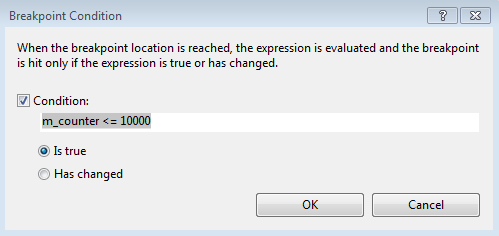Details of Conditional Breakpoints
TwinCAT C++ provides conditional breakpoints. Details of the formulation of these conditions can be found here.

Unlike the Visual Studio C++ conditional breakpoints, the TwinCAT conditions are compiled and subsequently transferred to the target system so that they can be used during short cycle times.
| |
Damage to plants and personal injuries due to unexpected behavior of the machine / plant Breakpoints change the behavior of the machine or plant. Depending on the machine being controlled, the machine or workpieces may be damaged or the health and life of people may be endangered. Make sure that the changed behavior of the controlled system does not cause any damage and be sure to note the plant documentation. |
The option buttons offer two options that are described separately.
Option: Is true
Conditions are defined with the help of logical terms, comparable to the conjunctive normal forms.
They are formed from a combination of Maxterms connected with "&&":
(Maxterm1 && Maxterm2 && ... && MaxtermN)wherein each Maxterm represents a combination of || associated conditions:
(condition1 ||condition2 || ... || conditionN )Possible comparison operators: ==,!=, <=, >=, <, >
Observe the Live Watch window for the determination of the available variables. All listed variables can be used for the formulation of conditions. This includes TMC-defined symbols as well as local member variables.
Samples:
m_counter == 123 && hr != 0
m_counter == 123 || m_counter2 == 321 && hr == 0
m_counter == 123
Monitoring module instances
The OID of the object is stored in m_objId, so the monitoring of the OID can look like this m_objId == 0x01010010
Monitoring of tasks
A special variable #taskId is provided to access the OID of the calling task. E.g.: #taskID == 0x02010010
Option: Has changed
The option “Has changed“ is simple to understand: By providing variable names, the value will be monitored and execution will be held, if the value has changed from the cycle before.
Samples:
m_counter
m_counter && m_counter2
